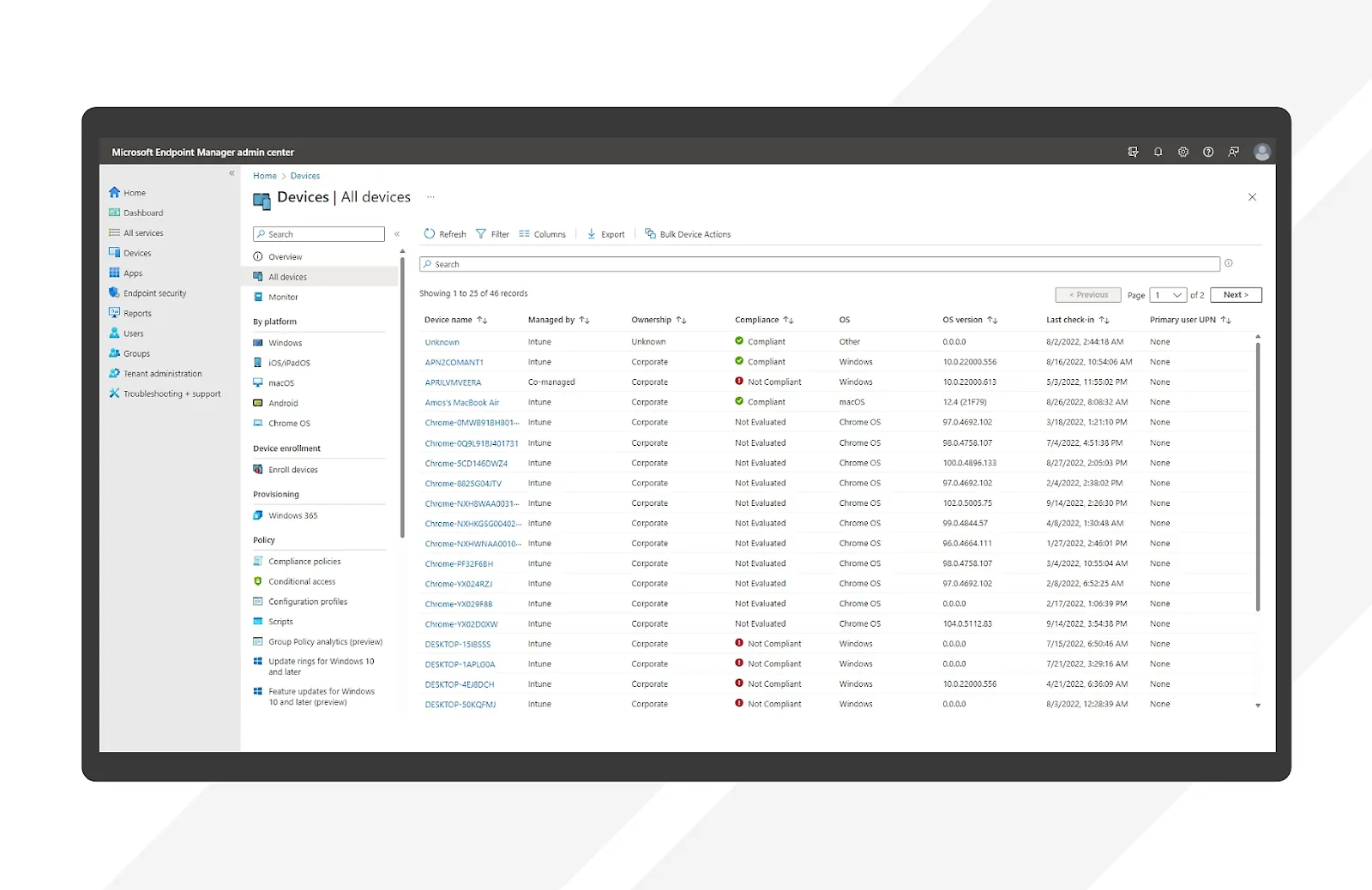We Review Microsoft Intune’s Pricing: Is it worth it?

Helpful Summary
- Overview: In this guide, we provide a detailed analysis of Microsoft Intune's pricing, features, advantages, and drawbacks, focusing on whether it is worth the investment for your organization.
- Why you can trust us: We have practical experience with Microsoft Intune as our tool integrates seamlessly with BlueTally to enhance your IT asset management capabilities.
- Why it matters: Intune's robust device and application management capabilities enhance security, compliance, and productivity, making it a valuable tool for organizations managing diverse device ecosystems.
- Action points: Evaluate Intune's three-tiered pricing plans—Plan 1, Plan 2, and Intune Suite—based on your organization's specific security and management needs, and consider starting with the free trial to assess its suitability.
- Further research: Explore additional resources on endpoint management, compare Intune with other MDM solutions, and review user testimonials to complement your decision-making process.
You’re likely aware of Microsoft Intune's device management capabilities. From enabling secure mobile device management to providing seamless application deployment, Intune stands out with its comprehensive security features and integration with other Microsoft services.
If your organization is considering Microsoft Intune but wants to know more about its pricing compared to other mobile device management (MDM) solutions, you’ve come to the right place. This article will explore Intune's pricing options, key features, advantages, and drawbacks. This way, you can understand whether the software meets both your budget and IT requirements.
Why Listen To Us?
At BlueTally, we have first-hand experience with Microsoft Intune. Our tool integrates seamlessly with Intune, enabling comprehensive asset management by synchronizing device data across both platforms. For instance, one of our clients successfully integrated their 439 devices from Intune into BlueTally, which significantly streamlined their processes, saved substantial time, and improved data accuracy.

This integration allows for real-time updates, automated workflows, and a unified view of your IT environment, enhancing overall operational efficiency and reliability. With BlueTally, you can leverage Intune's full potential for a robust and efficient asset management solution.
What is Intune?

Microsoft Intune is a cloud-based platform that provides application and device management solutions. It helps businesses secure and manage employees' devices, including smartphones, laptops, and virtual endpoints.
With Intune, organizations can ensure all devices, including bring-your-own-device (BYOD) options, comply with security standards. It enables the enforcement of password policies, data encryption, and necessary configurations. This allows employees to work securely on their devices.
A standout feature of Intune is its application management capability. Organizations can restrict access to specific apps, manage app updates, and protect corporate data within apps. This functionality helps prevent data breaches and safeguard sensitive information.
Intune’s Key Features
Intune offers a robust set of features that make it a powerful tool for managing devices and applications in your organization. Here are some of its key features:
Device Management
Intune allows you to manage all devices within your organization, whether they are corporate-owned or personal devices used by employees. For instance, a healthcare organization can use Intune to ensure that doctors and nurses can securely access patient records from their smartphones. This way, healthcare professionals can provide timely and efficient care while maintaining the confidentiality and security of sensitive patient information.
Automate Policy Deployment
Intune enables you to create and automate the deployment of various policies related to security, apps, and device configuration. With it, your organization can set up a policy that automatically updates security software on all employee devices. This automation reduces the administrative burden, ensuring consistency across the organization.
Security and Compliance
With Intune, you can set stringent security requirements such as device encryption, antivirus protection, and compliance checks. You can also integrate it with Microsoft Defender for Endpoint and other third-party security services.
For example, a retail company can use Intune to ensure that all point-of-sale (POS) devices are encrypted and have active antivirus protection. With this level of security, the company can protect sensitive customer data, prevent security breaches, and maintain compliance with industry regulations.
Self-Service
Intune provides a self-service option that enables users to manage their devices independently through the Company Portal app or website. Employees can perform actions such as resetting their PIN, installing apps, and joining necessary groups without needing IT support. This is particularly useful for a large enterprise because this feature can significantly reduce the helpdesk workload.
Advanced Endpoint Management/Remote Actions
Microsoft Intune allows IT administrators to manage and secure devices remotely. They can reset passwords, wipe data from lost or stolen devices, and lock devices that pose a security risk.
For instance, in a financial institution, if an employee's smartphone containing sensitive financial data is lost, the IT administrator can quickly wipe all data from the device to prevent unauthorized access. Also, if a device shows signs of a potential security breach, it can be locked remotely to avoid any further risk.
Web-Based Admin Center
Intune's admin center allows administrators to manage devices from any location with an internet connection. The admin center includes robust reporting and analytics features. These features offer insights into device compliance, app usage, and security incidents.
Microsoft Autopilot
Intune supports Microsoft Autopilot, simplifying new Windows device deployment and management. This feature provides an Out-of-Box Experience (OOBE) where IT administrators can customize setup profiles according to organizational needs.
For example, a tech startup can use Autopilot to pre-configure new laptops with necessary settings, applications, and security policies. This will enable new employees to start working productively after unboxing their devices.
Intune's Pricing Structure

Intune offers a three-tiered subscription base plan model, each designed to cater to businesses of varying sizes and needs, showcasing its scalability.
The multiple-price plan allows you to choose the one that best suits your organization. Here is the breakdown of how Microsoft Intune pricing works:
Intune Subscription Plans
1. Microsoft Intune Plan 1: This plan is designed for core application and device management features. It includes device enrollment, configuration, compliance policies, app deployment, and basic security features.
This plan also includes Microsoft 365 E3, E5, F1, and F3, Enterprise Mobility + Security E3 and E5, and Business Premium plans. It is ideal for organizations looking for an essential management solution without complexity.
2. Microsoft Intune Plan 2: This is an add-on to Plan 1, offering advanced features such as enhanced security and analytics. While this plan does come with additional costs, it is a suitable choice for organizations with more complex security needs. This provides them with the necessary tools to meet their requirements.
3. Microsoft Intune Suite: This is the most advanced plan that includes all of Intune's features. These features include remote help, specialty device management, advanced endpoint analytics, endpoint privilege management, and Tunnel for Mobile Application Management.
The suit plan comes with Microsoft Security and Microsoft 365, which enable data science and AI to increase automation. It is ideal for larger enterprises that need more complex solutions.
Pricing Breakdown
.webp)
Key Note: Intune Plan 2 and Suite are add-ons to Plan 1. You’ll need to subscribe to Plan 1 before you can subscribe to Plan 2 and Suite. Those add-ons cost $4 for Plan 2 and $10 for the Suite.
Customers who don't subscribe to any of these bundles can get Plan 1 as a standalone license. In addition, Microsoft offers a standalone license for devices that are not tied to specific users, such as kiosks or shared computers.
Fortunately, Intune allows you to test a package at no cost through its free trial.
Intune Pros and Cons
Before choosing the right software for your business or organization, it is crucial to consider its pros and cons. The following is the breakdown of Intune's pros and cons.
Pros:
- Intune allows comprehensive device management across platforms, including Android, iOS, Windows, and macOS.
- Intune works seamlessly with Microsoft services, such as Office 365 and Azure Active Directory, to enhance productivity and management experience.
- User-friendly interface that makes easy deployment, management, and learning curve for IT admins.
- It offers robust security features such as conditional access, compliance policies, and integration with Microsoft Defender.
- It is a cloud-based system that enables easy access and scalability.
Cons:
- Since Intune is a cloud-based system, it requires a reliable internet connection for optimal performance.
- It may not support some advanced or third-party service integration.
- Some advanced features and configurations may require additional expertise and training, which can be challenging for organizations without dedicated IT staff.
Intune Pricing Summary
Intune offers three subscription plans to meet various organizational needs:
- Intune Plan 1: $8 per monthly user, includes essential device and application management features. This plan is ideal for small—to medium-sized businesses that need these features at an affordable price.
- Intune Plan 2: This is an add-on $4 per user per month with advanced management capabilities to Plan 1. It is suited for larger organizations or those with more complex needs.
- Intune Suite: $10 per monthly user, combining comprehensive endpoint management and security solutions. It is best for enterprises needing comprehensive endpoint management and robust security solutions.
Enhance Your Intune Experience With BlueTally’s Integration
Microsoft Intune is a powerful tool that is highly scalable and suitable for businesses of various sizes. It is undoubtedly one of the most trusted endpoint management software used by many organizations.
If you’re okay with the pricing and have decided to subscribe to Microsoft Intune, don't forget that it seamlessly integrates with BlueTally to enhance your endpoint management experience.
You’ll get to enjoy additional features like streamlined asset tracking, efficient inventory management, and advanced reporting capabilities. Learn more about BlueTally here.






